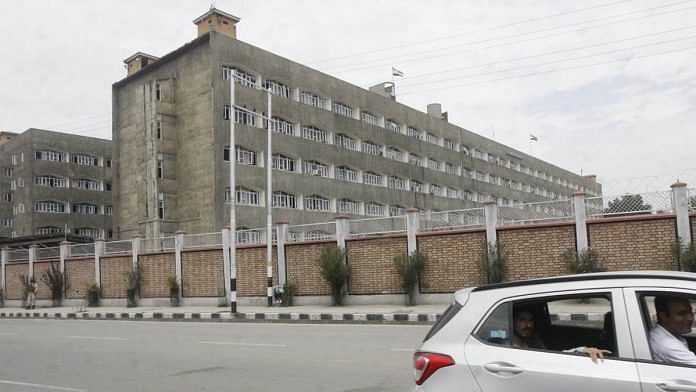New Delhi: A year after Jammu and Kashmir’s civil service cadre was merged with that of Arunachal Pradesh, Goa, Mizoram and Union Territories (AGMUT), the Ministry of Home Affairs (MHA), in an order dated 9 March, has reorganised the AGMUT cadre.
According to the order, J&K has been allotted 70 Indian Police Service (IPS) posts and Ladakh has been given 10. Apart from these 80 IPS positions, both Union territories have state service cadres (officers conferred IPS through promotion) too.
“The total number of IPS officers for J&K stood at around 80 earlier as well,” said a senior IPS officer serving in the Union territory, while adding that “now J&K, with inclusion in the AGMUT cadre and graded as a ‘Hard Area’ like some of the north-eastern states, is likely to get all IPS positions filled”.
“There are special incentives for officers who serve in Hard Areas. The number of J&K cadres was falling over the years, but with this reorganisation, we may expect an increase in intake and more IPS officers posted in the region,” added the officer.
“While J&K, before the abrogation of Article 370 had a sanctioned cadre strength of 147, many posts fell vacant,” he said.
With the inclusion of the bifurcated J&K and Ladakh Union territories, the government has increased the strength of the AGMUT IPS cadre by 148 officers (including the state service cadres as well as the all-India service officers) from 2017, when the last reorganisation took place.
ThePrint has copies of both reorganisation orders, issued in 2017 and in March 2022.
According to senior IPS officers, the government may also send officers from other UTs to J&K if need be, as it’s now part of the unified AGMUT cadre. Under AGMUT, Delhi has 82 IPS positions, the highest in the cadre.
“The numbers for total IPS positions, including Jammu & Kashmir and Ladakh, did not change much from what it was before abrogation, but now the government is serious about filling up all positions, so it may need an augmentation in intake through the Union Public Service Commission (UPSC). Last year, 180 IPS cadres were taken through UPSC,” added the officer.
Also read: Situation in Kashmir improved after removal of Article 370, says CRPF DG Kuldiep Singh
Took two-and-a-half years
It has taken almost two-and-a-half years for Jammu & Kashmir to get a dedicated civil services cadre after the abrogation of Article 370 in August 2019. A series of meetings took place between MHA officers and the J&K local administration in this period.
The former J&K cadre was abolished and merged with AGMUT in January last year. In December 2021, the government analysed the situation and conducted cadre review procedures for both Union territories.
After going through inputs from the local administration and security agencies, the MHA has now reorganised the senior IPS posts and allotted 70 positions for J&K and 10 for Ladakh, in addition to the state service officers.
According to a senior IPS officer in J&K, “After several meetings, a number of required IPS positions was placed before the government. It was around 154. However, what we have got now are similar numbers as in the undivided state. It meets our requirement, but some positions were reorganised or some posts were merged into one.”
“Jammu & Kashmir has always been the most sensitive area. In the past two years, the state was running with its existing IPS officers and some officers were sent here on deputation. It is always good to have our own cadre, which we have got now. We are expecting to get fresh recruitments soon,” he added.
J&K and Ladakh’s categorisation this January as ‘Hard Areas’ is expected to help boost the recruitment of IPS officers for these territories, said sources in the civil services, as officers deputed in these areas are eligible for certain incentives, as mentioned in the ‘guidelines for transfer/posting of IAS/ IPS officers of joint AGMUT cadre’, dated November 2016.
AGMUT turns second-largest cadre
IPS posts were last fixed for the AGMUT cadre in 2017, when the sanctioned cadre strength was 309. With the inclusion of J&K and Ladakh, the sanctioned cadre strength for AGMUT has gone up to 457.
This is currently the second-largest civil service cadre, comprising three states — Arunachal Pradesh, Goa and Mizoram — and eight UTs, namely Andaman & Nicobar, Chandigarh, Daman & Diu, NCT Delhi, Lakshadweep, Puducherry, J&K and Ladakh. The largest civil service cadre is Uttar Pradesh with 489 authorised positions.
These positions include state service officers too. The number of sanctioned IPS cadre posts for AGMUT now stands at 248, while it is 265 for Uttar Pradesh. For AGMUT, it was 168 in 2017.
(Edited by Nida Fatima Siddiqui)
Also read: Rajya Sabha discussion on J&K Budget turns into debate on ‘Kashmir Files’, opposition slams BJP



